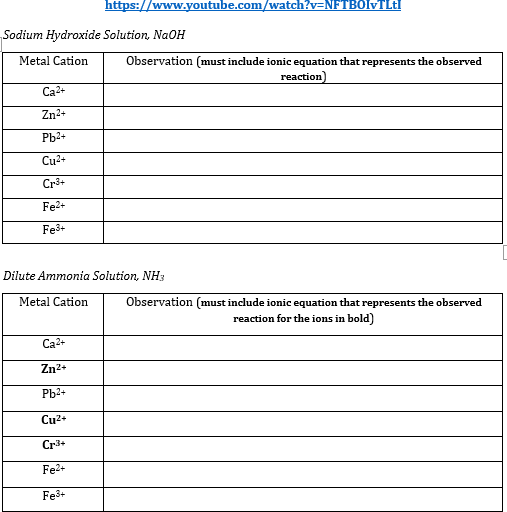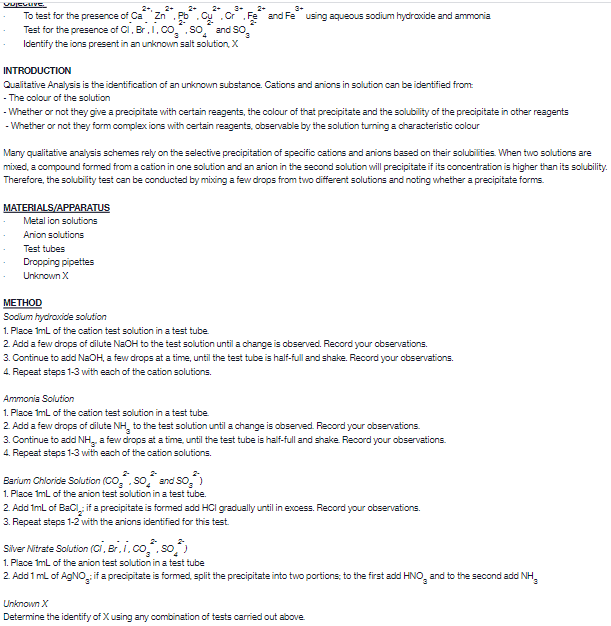https://www.youtube.com/watch?v=NFTB0IVTLEI Sodium Hydroxide Solution, NaOH Metal Cation Observation (must include ionic equation that represents the observed reaction) Ca2+ Zn2+ Pb2+ Cu2+ Cr3+ Fe2+ Fe3+ Dilute Ammonia Solution, NH3 Metal Cation Observation (must include ionic equation that represents the observed reaction for the ions in bold) Ca2+ Zn2+ Pb2+ Cu2+ Cr3+ Fe2- Fes-
https://www.youtube.com/watch?v=NFTB0IVTLEI Sodium Hydroxide Solution, NaOH Metal Cation Observation (must include ionic equation that represents the observed reaction) Ca2+ Zn2+ Pb2+ Cu2+ Cr3+ Fe2+ Fe3+ Dilute Ammonia Solution, NH3 Metal Cation Observation (must include ionic equation that represents the observed reaction for the ions in bold) Ca2+ Zn2+ Pb2+ Cu2+ Cr3+ Fe2- Fes-
Chapter17: Complexation And Precipitation Reactions And Titrations
Section: Chapter Questions
Problem 17.5QAP
Related questions
Question
100%
the following experiment is reference from this video link, they are the first 2 experiments ;
reference
https://www.youtube.com/watch?v=NFTBOIvTLtI

Transcribed Image Text:https://www.youtube.com/watch?v=NFTBOlvTLtl
Sodium Hydroxide Solution, NaOH
Metal Cation
Observation (must include ionic equation that represents the observed
Cą2+
reaction)
Zn2+
Pb2+
Cu2+
Cr3+
Fe2+
Fe3+
Dilute Ammonia Solution, NH3
Metal Cation
Observation (must include ionic equation that represents the observed
reaction for the ions in bold)
Ca2+
Zn2+
Pb2+
Cu2+
Cr3+
Fe2+
Fe3+

Transcribed Image Text:2+, 2-
3-
To test for the presence of Ca Zn.Pb.Cu.Or .Fe and Fe using aqueous sodium hydroxcide and ammonia
Test for the presence of CI, Br.1, 0o," so, and So,
Identify the ions present in an unknown salt solution, X
INTRODUCTION
Qualitative Analysis is the identification of an unknown substance. Cations and anions in solution can be identified from:
- The colour of the solution
- Whether or not they give a precipitate with certain reagents, the colour of that precipitate and the solubility of the precipitate in other reagents
- Whether or not they form complex ions with certain reagents, observable by the solution turning a characteristic colour
Many qualitative analysis schemes rely on the selective precipitation of specific cations and anions based on their solubilities. When two solutions are
mixed, a compound formed from a cation in one solution and an anion in the second solution will precipitate if its concentration is higher than its solubility.
Therefore, the solubility test can be conducted by mixing a few drops from two different solutions and noting whether a precipitate forms.
MATERIALS/APPARATUS
Metal ion solutions
Anion solutions
Test tubes
Dropping pipettes
Unknown X
МЕТHOD
Sodium hydroxide solution
1. Place Iml of the cation test solution in a test tube
2. Add a few drops of ailute NaOH to the test solution until a change is observed. Record your observations.
3. Continue to add N2OH, a few drops at a time, until the test tube is half-full and shake. Record your observations.
4. Repeat steps 1-3 with each of the cation solutions.
Ammonia Solution
1. Place Iml of the cation test solution in a test tube
2. Add a few drops of dilute NH, to the test solution until a change is observed. Record your observations.
3. Continue to add NH, a few drops at a time, until the test tube is half-full and shake Record your observations.
4. Repeat steps 1-3 with each of the cation solutions.
Barium Chloride Solution (Co, so and So,)
1. Place Iml of the anion test solution in a test tube.
2. Add iml of BaCI, if a precipitate is formed add HCl gradually until in excess. Record your observations.
3. Repeat steps 1-2 with the anions identified for this test.
Siver Nitrte Solution (Ci, B.i.co so)
1. Place iml of the anion test solution in a test tube
2. Add 1 ml of AgNO, if a precipitate is formed, split the precipitate into two portions; to the first add HNO, and to the second add NH.
Lnknown X
Determine the identify of X using any combination of tests carried out above
Expert Solution
This question has been solved!
Explore an expertly crafted, step-by-step solution for a thorough understanding of key concepts.
This is a popular solution!
Trending now
This is a popular solution!
Step by step
Solved in 2 steps with 2 images

Knowledge Booster
Learn more about
Need a deep-dive on the concept behind this application? Look no further. Learn more about this topic, chemistry and related others by exploring similar questions and additional content below.Recommended textbooks for you

